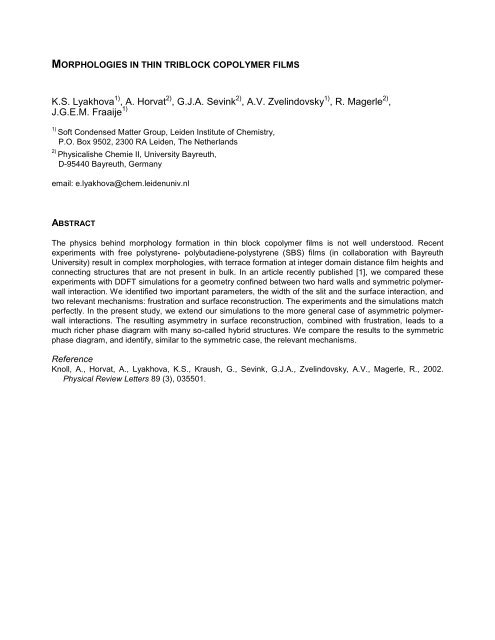Collapse of polymer brushes grafted onto planar ... - Wageningen UR
Collapse of polymer brushes grafted onto planar ... - Wageningen UR
Collapse of polymer brushes grafted onto planar ... - Wageningen UR
Create successful ePaper yourself
Turn your PDF publications into a flip-book with our unique Google optimized e-Paper software.
MORPHOLOGIES IN THIN TRIBLOCK COPOLYMER FILMS<br />
K.S. Lyakhova 1) , A. Horvat 2) , G.J.A. Sevink 2) , A.V. Zvelindovsky 1) , R. Magerle 2) ,<br />
J.G.E.M. Fraaije 1)<br />
1)<br />
S<strong>of</strong>t Condensed Matter Group, Leiden Institute <strong>of</strong> Chemistry,<br />
P.O. Box 9502, 2300 RA Leiden, The Netherlands<br />
2)<br />
Physicalishe Chemie II, University Bayreuth,<br />
D-95440 Bayreuth, Germany<br />
email: e.lyakhova@chem.leidenuniv.nl<br />
ABSTRACT<br />
The physics behind morphology formation in thin block co<strong>polymer</strong> films is not well understood. Recent<br />
experiments with free polystyrene- polybutadiene-polystyrene (SBS) films (in collaboration with Bayreuth<br />
University) result in complex morphologies, with terrace formation at integer domain distance film heights and<br />
connecting structures that are not present in bulk. In an article recently published [1], we compared these<br />
experiments with DDFT simulations for a geometry confined between two hard walls and symmetric <strong>polymer</strong>wall<br />
interaction. We identified two important parameters, the width <strong>of</strong> the slit and the surface interaction, and<br />
two relevant mechanisms: frustration and surface reconstruction. The experiments and the simulations match<br />
perfectly. In the present study, we extend our simulations to the more general case <strong>of</strong> asymmetric <strong>polymer</strong>wall<br />
interactions. The resulting asymmetry in surface reconstruction, combined with frustration, leads to a<br />
much richer phase diagram with many so-called hybrid structures. We compare the results to the symmetric<br />
phase diagram, and identify, similar to the symmetric case, the relevant mechanisms.<br />
Reference<br />
Knoll, A., Horvat, A., Lyakhova, K.S., Kraush, G., Sevink, G.J.A., Zvelindovsky, A.V., Magerle, R., 2002.<br />
Physical Review Letters 89 (3), 035501.

















